Recovery of Ultra-Fine Tungsten and Tin from Slimes Using Large-Scale SLon-2400 Centrifugal Separator
Abstract
1. Introduction
2. The SLon Centrifugal Separator and Characterization of Slimes
2.1. The SLon-2400 Large-Scale Centrifugal Separator and Separation Procedure
2.2. Description of Tungsten and Tin Slimes
3. Results and Discussion
3.1. Recovery of Ultra-Fine Tungsten from Slime
3.1.1. Effect of Centrifugal Acceleration on the Separation Performance
3.1.2. Effect of Slurry Solid Concentration on the Tseparation Performance
3.1.3. Effect of Feed Volume Flow Rate on the Separation Performance
3.1.4. Effect of Rinsing Water on the Separation Performance
3.2. Recovery of Ultra-Fine Tin from Slime
4. Conclusions
Author Contributions
Funding
Conflicts of Interest
References
- Angadi, S.I.; Sreenivas, H.; Jeon, H.; Baek, S.; Mishra, B.K. A review of cassiterite beneficiation fundamentals and plant practices. Miner. Eng. 2015, 70, 178–200. [Google Scholar] [CrossRef]
- Gao, Y. The characteristics and research advances of mineral processing technologies of Chinese tungsten resources. China Tungsten Ind. 2018, 45, 44–46. (In Chinese) [Google Scholar]
- Zhang, J.; Ding, J.; Nan, G. The characteristics and potential of tin resources in China. Geol. China 2015, 42, 839–851. (In Chinese) [Google Scholar]
- Foucaud, Y.; Dehine, Q.; Filippov, L.O.; Filippova, I.V. Application of Falcon centrifuge as a cleaner alternative from complex tungsten ore processing. Minerals 2019, 9, 448. [Google Scholar] [CrossRef]
- Burt, R.O.; Korinek, G.; Young, S.R.; Deveau, C. Ultrafine tantalum recovery strategies. Miner. Eng. 1995, 8, 859–870. [Google Scholar] [CrossRef]
- Ergün, L.; Ersayin, S. Studies on pinched sluice concentration. Part I: The effects of operating variables and sluice geometry on the performance of pinched sluices. Miner. Eng. 2002, 15, 423–435. [Google Scholar] [CrossRef]
- Jones, T.A. Efficient enhanced gravity recovery of Zircon using the Kelsey centrifugal jig. In Proceedings of the DMS and Gravity Concentration Operations and Technology in South Africa, Johannesburg, South Africa, 18–20 July 2006; pp. 87–108. [Google Scholar]
- Majumder, A.K.; Barnwal, J.P. Modelling of enhanced gravity separator-present status. Miner. Process. Extra. Met. Rev. 2006, 27, 61–86. [Google Scholar] [CrossRef]
- Liu, D.; Wang, Y.; Jiang, T.; Sun, W.; Hu, Y. Study on pre-concentration efficiency of wolframite from tungsten ore using gravity and magnetic separations. Physicochem. Probl. Miner. Process. 2016, 52, 718–728. [Google Scholar]
- Fitzpatrick, R.; Hegarty, P.; Fergusson, K.; Rollinson, G.; Xie, W.; Mildren, T. Optimisation of a multi-gravity separator with novel modifications for the recovery of ferberite. Minerals 2018, 8, 191. [Google Scholar] [CrossRef]
- Tripathy, A.; Bagchi, S.; Biswal, S.K.; Meikap, B.C. Study of particle hydrodynamics and misplacement in liquid–solid fluidized bed separator. Chem. Eng. Res. Des. 2017, 117, 520–532. [Google Scholar] [CrossRef]
- Udaya Bhaskar, K.; Govindarajan, B.; Barnwal, J.P.; Venugopal, R.; Jakhu, M.R.; Rao, T.C. Performance and modeling studies of an MGS for graphite rejection in a lead concentrate. Int. J. Miner. Process. 2002, 67, 59–70. [Google Scholar] [CrossRef]
- Chen, L.; Ren, N.; Xiong, D. Application of SLon continuous centrifugal separators in recovering fine iron minerals from mining tailings. Met. Mine 2008, 1, 86–88. [Google Scholar]
- Chen, L.; Xiong, D.; Huang, H.; Peng, Z.; Xiong, T.; Rao, Y.; Zeng, J. A three-Conical Drum for SLon Centirfugal Separator. Chinese Invention Patent 20191022606.X, 27 August 2019. [Google Scholar]
- Zhang, H.; Zeng, J.; Xie, H.; Guan, C.; Chen, L. Enhanced separation for ilmenite tailings with a novel HGMS-flotation process. Sep. Sci. Technol. 2017, 2, 24–28. [Google Scholar] [CrossRef]
- Chen, L.; Ren, N.; Xiong, D. Experimental study on performance of a continuous centrifugal separator for reconcentrating fine hematite. Int. J. Miner. Process. 2008, 87, 9–16. [Google Scholar] [CrossRef]
- Zhong, N. Application of SLon centrifugal separator to separating fine tungsten in Dajishan. Nonferr. Met. (Miner. Process. Sect.) 2016, 2, 79–81. [Google Scholar]
- Chen, L.; Liu, S.; Wen, S. Performance of a full-scale continuous centrifugal separator in reconcentrating fine hematite from tailings. Miner. Metall. Proc. 2010, 27, 133–140. [Google Scholar]
- Lan, J.; Ji, X.; Rao, R. The flotation experimental study on one tin slime in Guangxi. Yunnan Metall. 2016, 45, 47–53. (In Chinese) [Google Scholar]
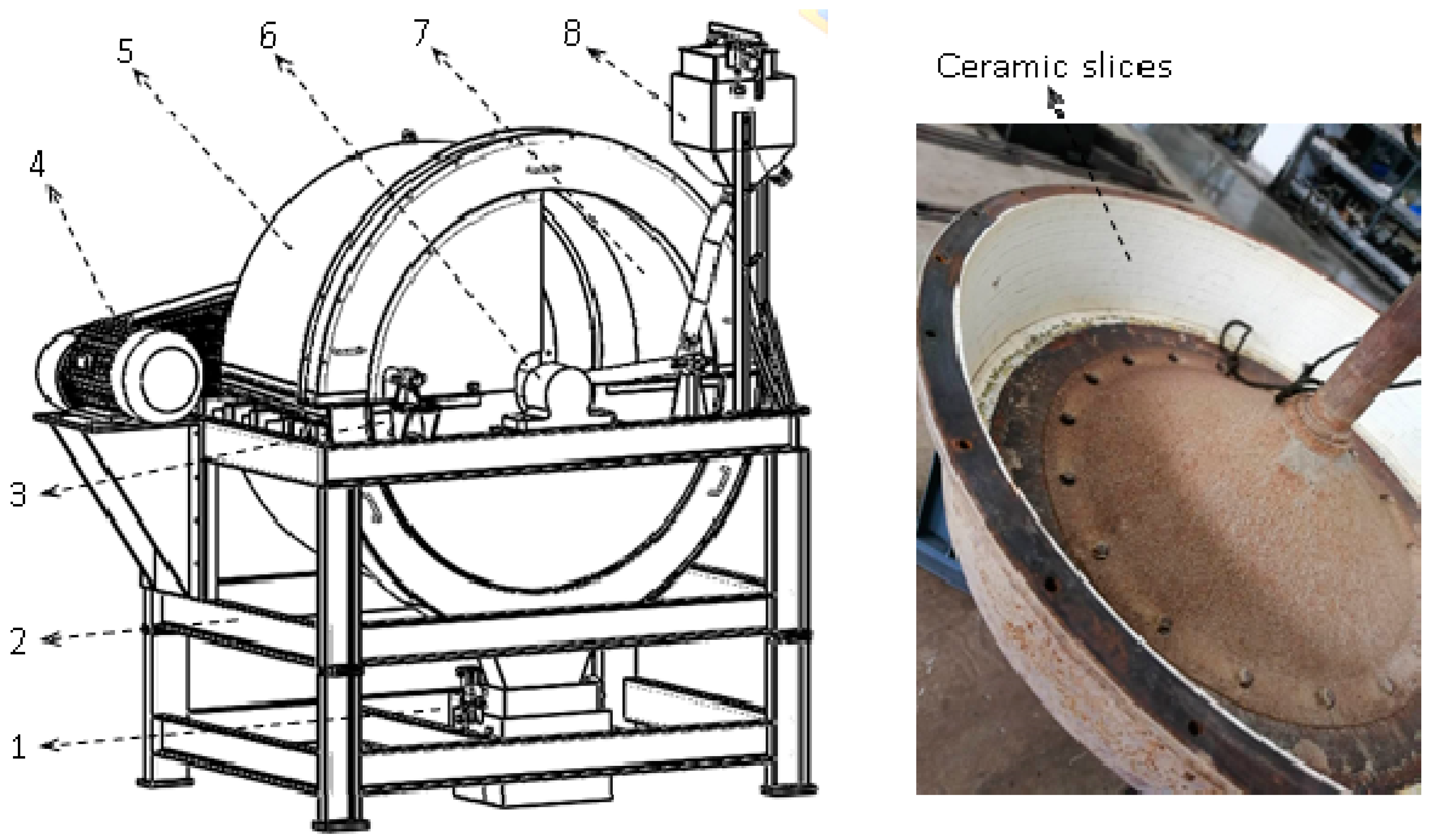
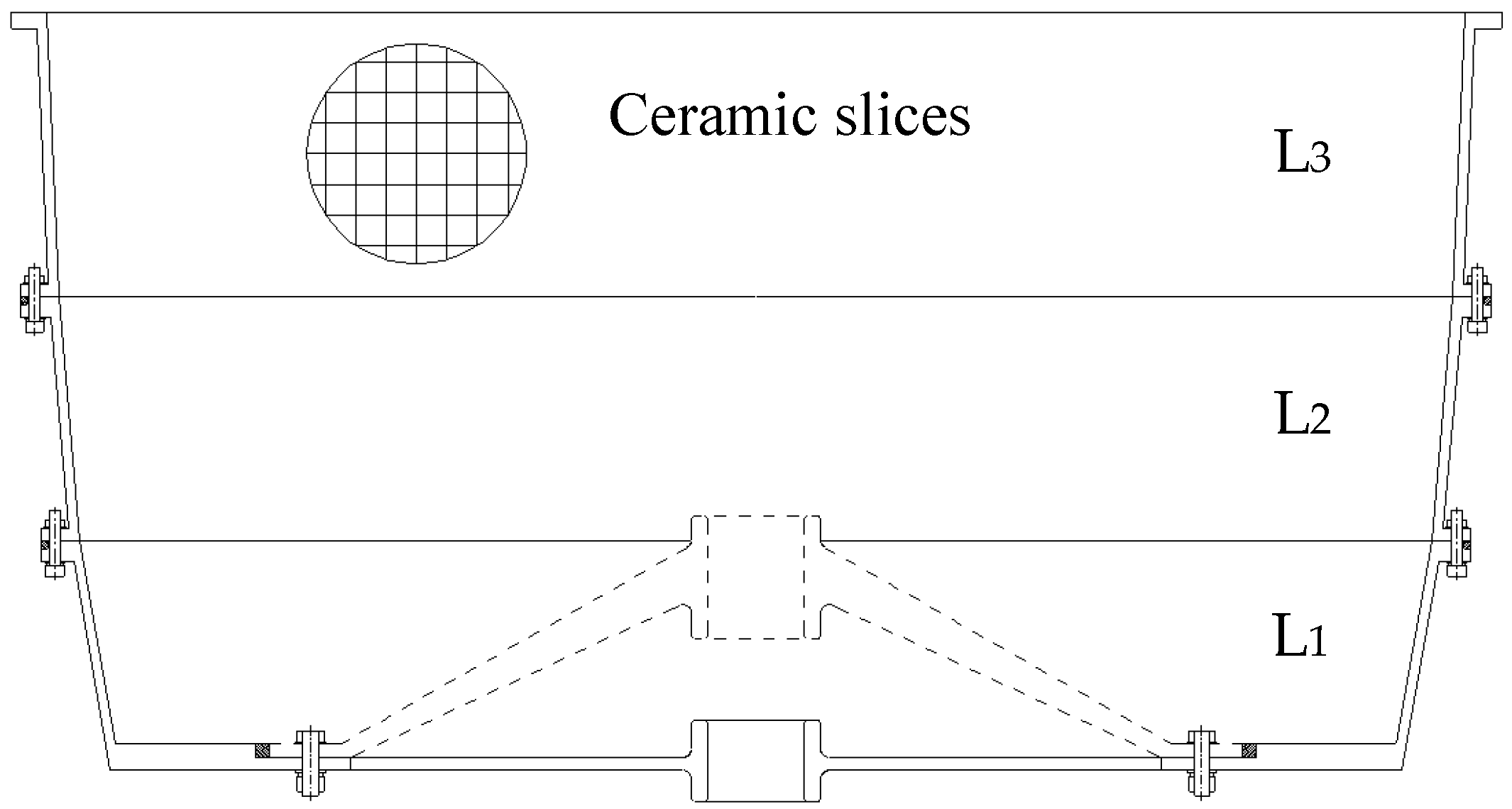

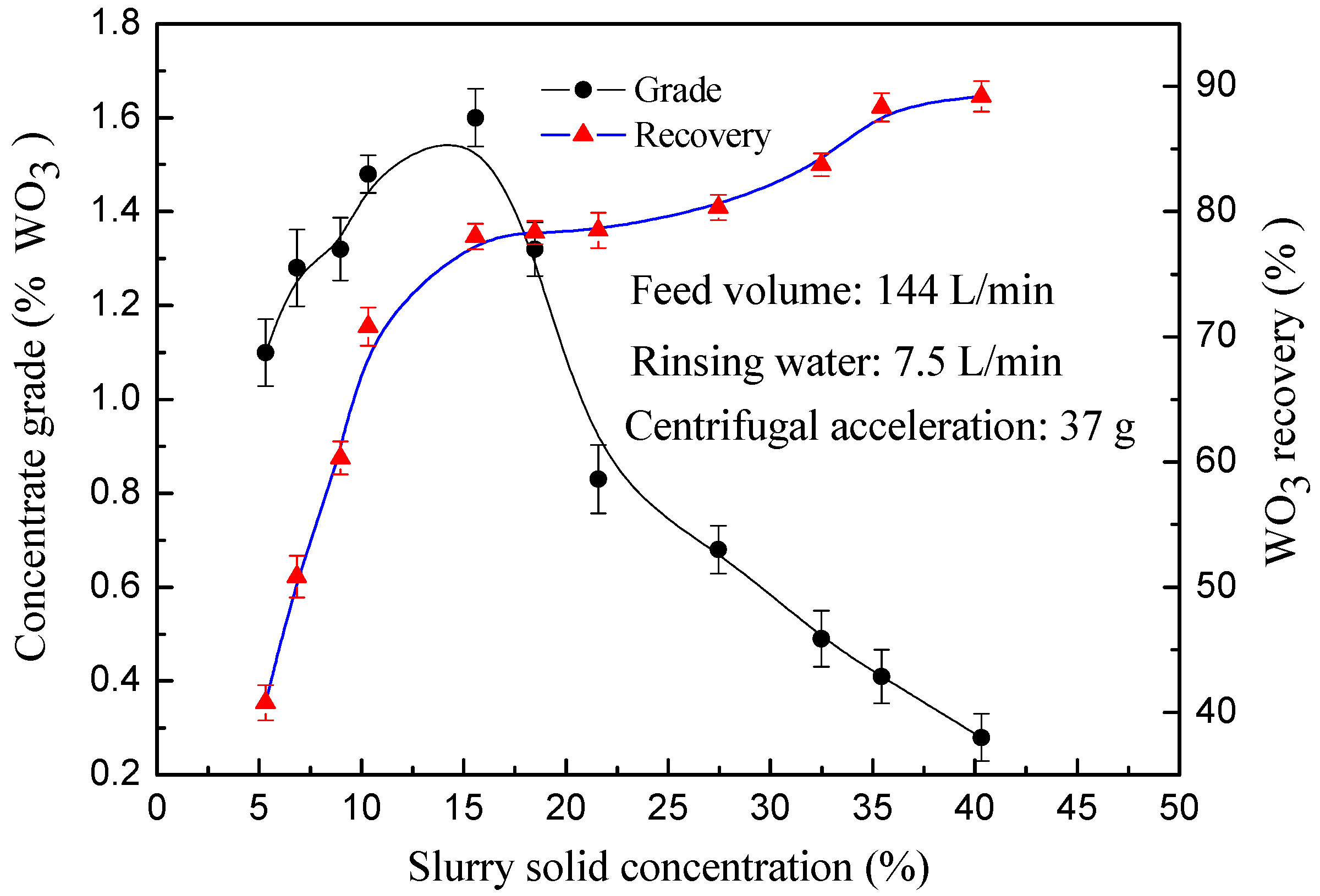
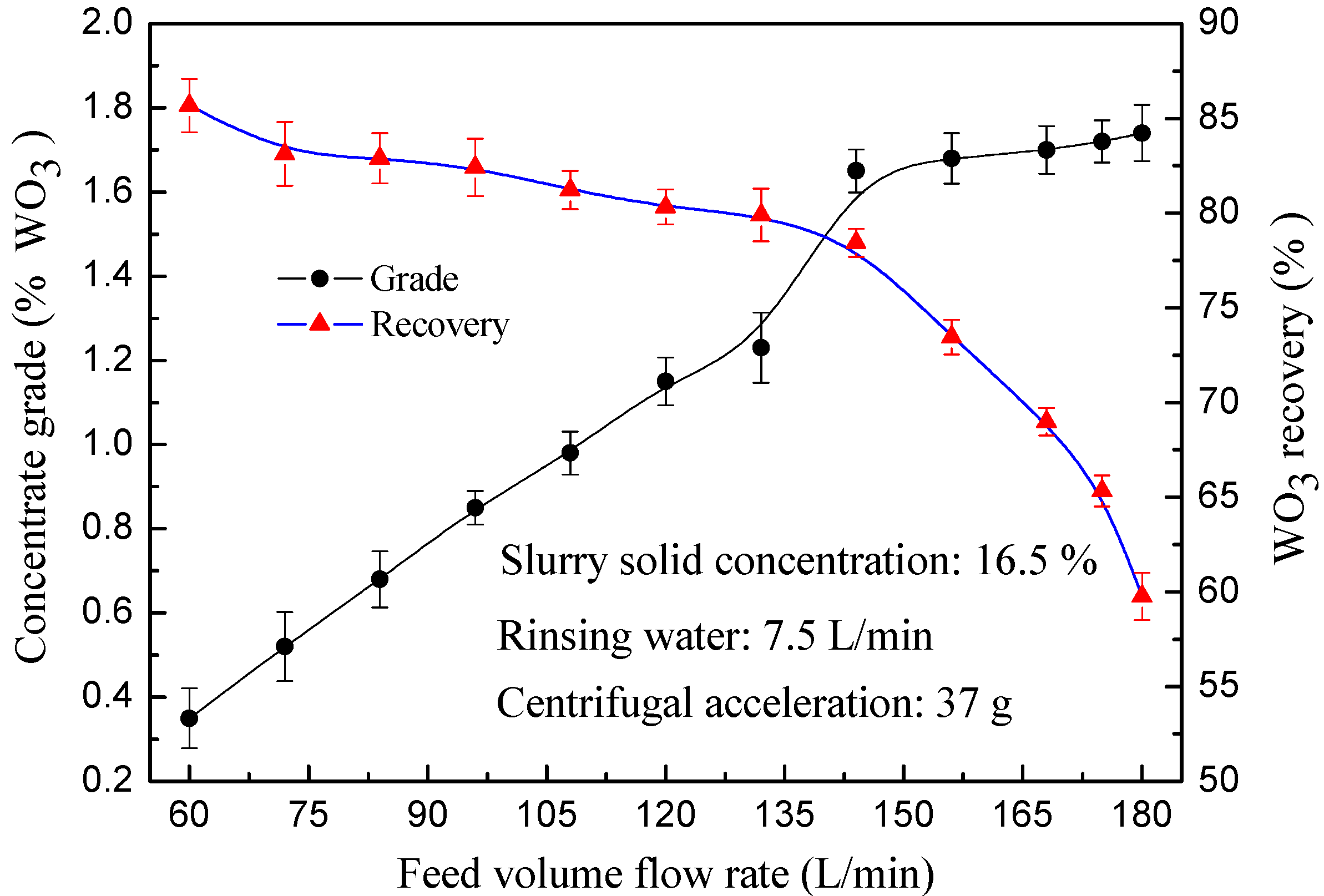
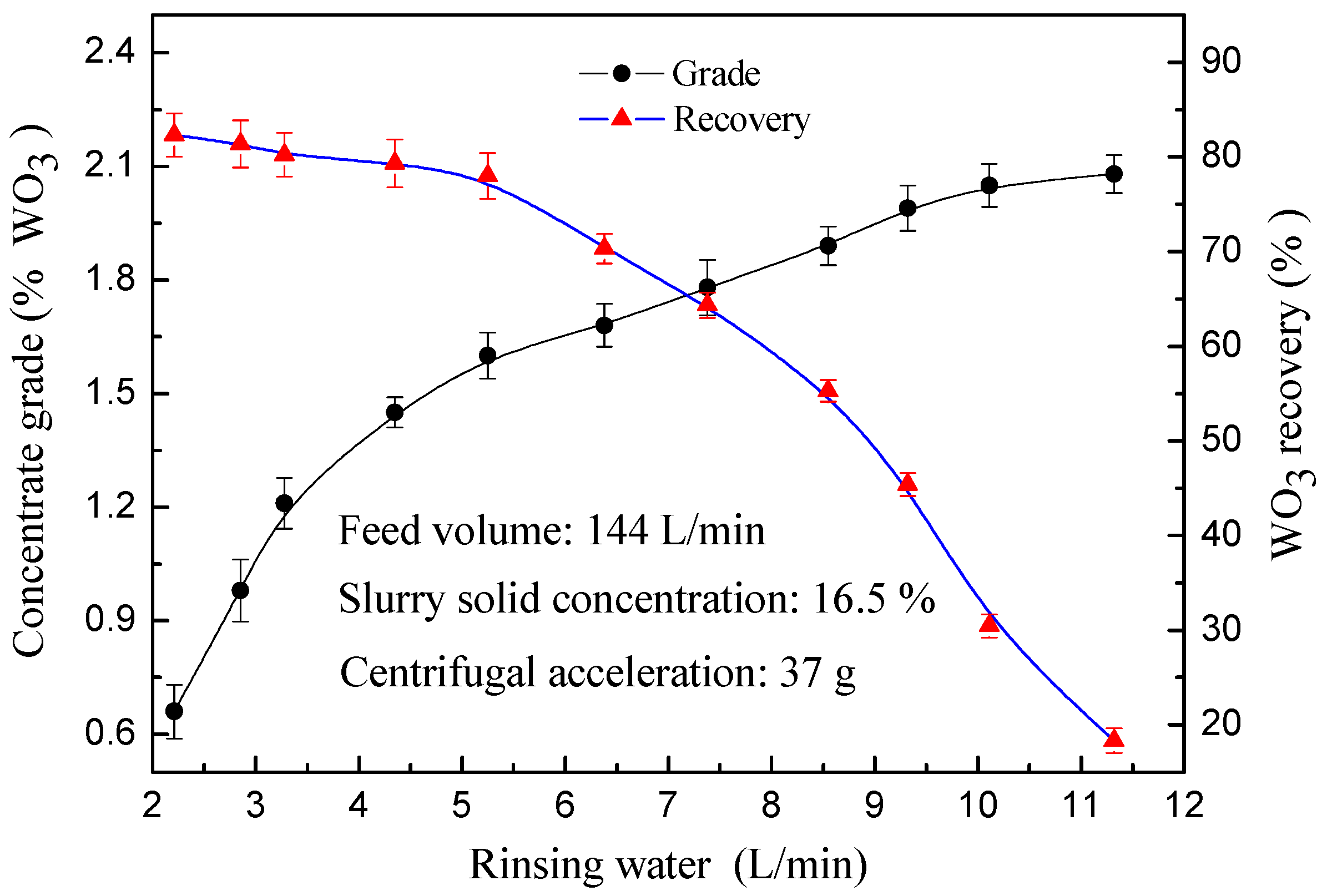

| Elements | WO3 | SiO2 | Al2O3 | Bi | Cu | Mo | Sn | Others |
|---|---|---|---|---|---|---|---|---|
| Content (%) | 0.22 | 60.53 | 12.34 | 0.11 | 0.095 | 0.085 | 0.01 | 26.61 |
| Particle Size Range (mm) | Weight (%) | Grade (% WO3) | WO3 Distribution (%) |
|---|---|---|---|
| +0.074 | 0.54 | 0.10 | 0.24 |
| −0.074 + 0.04 | 17.94 | 0.11 | 8.81 |
| −0.04 + 0.020 | 41.24 | 0.23 | 42.37 |
| −0.020 | 40.28 | 0.27 | 48.58 |
| Tungsten slime | 100.00 | 0.22 | 100.00 |
| Elements | Sn | SiO2 | Al2O3 | Cu | Fe | Zn | S | Others |
|---|---|---|---|---|---|---|---|---|
| Content (%) | 0.27 | 68.85 | 5.25 | 0.09 | 5.12 | 4.76 | 0.10 | 15.56 |
| Particle Size Range (mm) | Weight (%) | Grade (% Sn) | Sn Distribution (%) |
|---|---|---|---|
| +0.074 | 2.25 | 0.08 | 0.67 |
| −0.074 + 0.037 | 22.97 | 0.19 | 16.27 |
| −0.037 + 0.020 | 43.27 | 0.26 | 41.94 |
| −0.020 | 31.51 | 0.35 | 41.12 |
| Tin slime | 100.00 | 1.65 | 100.00 |
| Particle Size Range (mm) | Weight (%) | Grade (% WO3) | WO3 Distribution (%) |
|---|---|---|---|
| +0.074 | 2.38 | 0.21 | 0.30 |
| −0.074 + 0.037 | 16.45 | 0.98 | 9.76 |
| −0.037 + 0.020 | 43.86 | 1.78 | 47.26 |
| −0.020 | 37.31 | 1.89 | 42.68 |
| Concentrate | 100.00 | 1.65 | 100.00 |
| Products | Mass Weight (%) | Grade (% Sn) | Recovery (% Sn) |
|---|---|---|---|
| SLon-2400 process | 13.82 | 1.56 | 79.85 |
| Sulfur concentrate | 1.31 | 0.16 | 0.78 |
| Tin concentrate | 1.11 | 16.23 | 66.70 |
| Tailings | 97.58 | 0.09 | 32.52 |
| Feed (slime) | 100.00 | 0.27 | 100.00 |
© 2020 by the authors. Licensee MDPI, Basel, Switzerland. This article is an open access article distributed under the terms and conditions of the Creative Commons Attribution (CC BY) license (http://creativecommons.org/licenses/by/4.0/).
Share and Cite
Xiong, T.; Ren, X.; Xie, M.; Rao, Y.; Peng, Y.; Chen, L. Recovery of Ultra-Fine Tungsten and Tin from Slimes Using Large-Scale SLon-2400 Centrifugal Separator. Minerals 2020, 10, 694. https://doi.org/10.3390/min10080694
Xiong T, Ren X, Xie M, Rao Y, Peng Y, Chen L. Recovery of Ultra-Fine Tungsten and Tin from Slimes Using Large-Scale SLon-2400 Centrifugal Separator. Minerals. 2020; 10(8):694. https://doi.org/10.3390/min10080694
Chicago/Turabian StyleXiong, Tao, Xiangjun Ren, Meifang Xie, Yuhuan Rao, Yongjun Peng, and Luzheng Chen. 2020. "Recovery of Ultra-Fine Tungsten and Tin from Slimes Using Large-Scale SLon-2400 Centrifugal Separator" Minerals 10, no. 8: 694. https://doi.org/10.3390/min10080694
APA StyleXiong, T., Ren, X., Xie, M., Rao, Y., Peng, Y., & Chen, L. (2020). Recovery of Ultra-Fine Tungsten and Tin from Slimes Using Large-Scale SLon-2400 Centrifugal Separator. Minerals, 10(8), 694. https://doi.org/10.3390/min10080694






